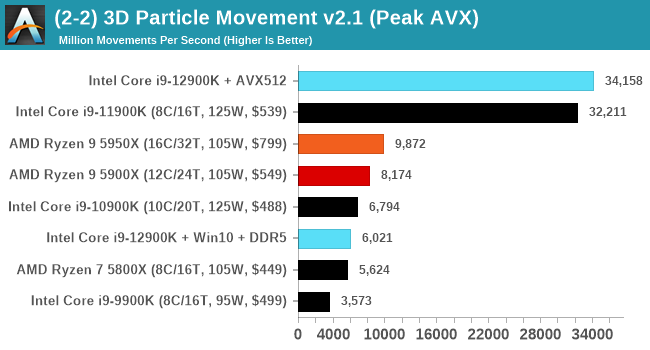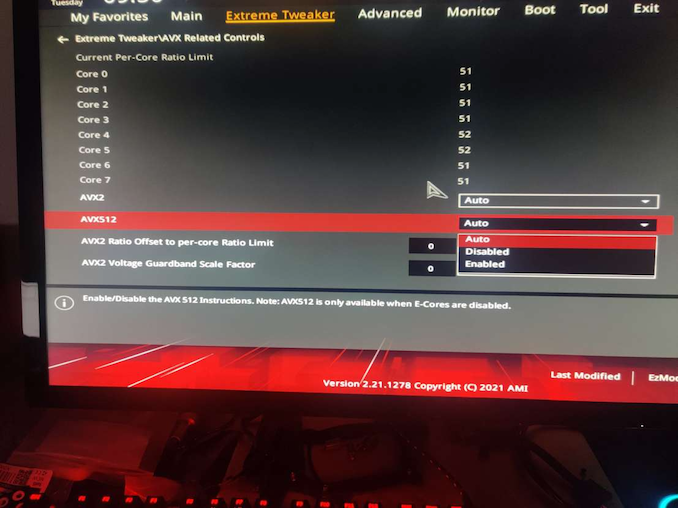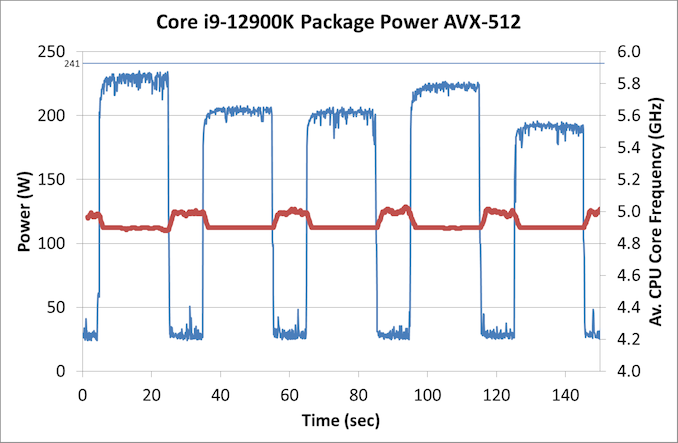The Intel 12th Gen Core i9-12900K Review: Hybrid Performance Brings Hybrid Complexity
by Dr. Ian Cutress & Andrei Frumusanu on November 4, 2021 9:00 AM ESTIntel Disabled AVX-512, but Not Really
One of the more interesting disclosures about Alder Lake earlier this year is that the processor would not have Intel’s latest 512-bit vector extensions, AVX-512, despite the company making a big song and dance about how it was working with software developers to optimize for it, why it was in their laptop chips, and how no transistor should be left behind. One of the issues was that the processor, inside the silicon, actually did have the AVX-512 unit there. We were told as part of the extra Architecture Day Q&A that it would be fused off, and the plan was for all Alder Lake CPUs to have it fused off.
Part of the issue of AVX-512 support on Alder Lake was that only the P-cores have the feature in the design, and the E-cores do not. One of the downsides of most operating system design is that when a new program starts, there’s no way to accurately determine which core it will be placed on, or if the code will take a path that includes AVX-512. So if, naively, AVX-512 code was run on a processor that did not understand it, like an E-core, it would cause a critical error, which could cause the system to crash. Experts in the area have pointed out that technically the chip could be designed to catch the error and hand off the thread to the right core, but Intel hasn’t done this here as it adds complexity. By disabling AVX-512 in Alder Lake, it means that both the P-cores and the E-cores have a unified common instruction set, and they can both run all software supported on either.
There was a thought that if Intel were to release a version of Alder Lake with P-cores only, or if a system had all the E-cores disabled, there might be an option to have AVX-512. Intel shot down that concept almost immediately, saying very succinctly that no Alder Lake CPU would support AVX-512.
Nonetheless, we test to see if it is actually fused off.
On my first system, the MSI motherboard, I could easily disable the E-cores. That was no problem, just adjust the BIOS to zero E-cores. However this wasn’t sufficient, as AVX-512 was still clearly not detected.
On a second system, an ASUS motherboard, there was some funny option in the BIOS.
Well I’ll be a monkey’s uncle. There’s an option, right there, front and centre for AVX-512. So we disable the E-cores and enable this option. We have AVX-512 support.
For those that have some insight into AVX-512 might be aware that there are a couple of dozen different versions/add-ons of AVX-512. We confirmed that the P-cores in Alder Lake have:
- AVX512-F / F_X64
- AVX512-DQ / DQ_X64
- AVX512-CD
- AVX512-BW / BW_X64
- AVX512-VL / VLBW / VLDQ / VL_IFMA / VL_VBMI / VL_VNNI
- AVX512_VNNI
- AVX512_VBMI / VBMI2
- AVX512_IFMA
- AVX512_BITALG
- AVX512_VAES
- AVX512_VPCLMULQDQ
- AVX512_GFNI
- AVX512_BF16
- AVX512_VP2INTERSECT
- AVX512_FP16
This is, essentially, the full Sapphire Rapids AVX-512 support. That makes sense, given that this is the same core that’s meant to be in Sapphire Rapids (albeit with cache changes). The core also supports dual AVX-512 ports, as we’re detecting a throughput of 2 per cycle on 512-bit add/subtracts.
For performance, I’m using our trusty 3DPMAVX benchmark here, and compared to the previous generation Rocket Lake (which did have AVX-512), the score increases by a few percent in a scenario which isn’t DRAM limited.

Now back in that Rocket Lake review, we noted that the highest power consumption observed for the chip was during AVX-512 operation. At that time, our testing showcased a big +50W jump between AVX2 and AVX-512 workloads. This time around however, Intel has managed to adjust the power requirements for AVX-512, and in our testing they were very reasonable:
In this graph, we’re showing each of the 3DPM algorithms running for 20 seconds, then idling for 10 seconds. Each one has a different intensity of AVX-512, hence why the power is up and down. IN each instance, the CPU used an all-core turbo frequency of 4.9 GHz, in line with non-AVX code, and our peak power observed is actually 233 W, well below the 241 W rated for processor turbo.
Why?
So the question then refocuses back on Intel. Why was AVX-512 support for Alder Lake dropped, and why were we told that it is fused off, when clearly it isn’t?
Based on a variety of conversations with individuals I won’t name, it appears that the plan to have AVX-512 in Alder Lake was there from the beginning. It was working on early silicon, even as far as ES1/ES2 silicon, and was enabled in the firmware. Then for whatever reason, someone decided to remove that support from Intel’s Plan of Record (POR, the features list of the product).
By removing it from the POR, this means that the feature did not have to be validated for retail, which partly speeds up the binning and testing/validation process. As far as I understand it, the engineers working on the feature were livid. While all their hard work would be put to use on Sapphire Rapids, it still meant that Alder Lake would drop the feature and those that wanted to prepare for Alder Lake would have to remain on simulated support. Not only that, as we’ve seen since Architecture Day, it’s been a bit of a marketing headache. Whoever initiated that dropped support clearly didn’t think of how that messaging was going to down, or how they were going to spin it into a positive. For the record, removing support isn’t a positive, especially given how much hullaballoo it seems to have caused.
We’ve done some extensive research on what Intel has done in order to ‘disable’ AVX-512. It looks like that in the base firmware that Intel creates, there is an option to enable/disable the unit, as there probably is for a lot of other features. Intel then hands this base firmware to the vendors and they adjust it how they wish. As far as we understand, when the decision to drop AVX-512 from the POR was made, the option to enable/disable AVX-512 was obfuscated in the base firmware. The idea is that the motherboard vendors wouldn’t be able to change the option unless they specifically knew how to – the standard hook to change that option was gone.
However, some motherboard vendors have figured it out. In our discoveries, we have learned that this works on ASUS, GIGABYTE, and ASRock motherboards, however MSI motherboards do not have this option. It’s worth noting that all the motherboard vendors likely designed all of their boards on the premise that AVX-512 and its high current draw needs would be there, so when Intel cut it, it meant perhaps that some boards were over-engineered with a higher cost than needed. I bet a few weren’t happy.
Update: MSI reached out to me and have said they will have this feature in BIOS versions 1.11 and above. Some boards already have the BIOS available, the rest will follow shortly.
But AVX-512 is enabled, and we are now in a state of limbo on this. Clearly the unit isn’t fused off, it’s just been hidden. Some engineers are annoyed, but other smart engineers at the motherboard vendors figured it out. So what does Intel do from here?
First, Intel could put the hammer down and execute a scorched earth policy. Completely strip out the firmware for AVX-512, and dictate that future BIOS/UEFI releases on all motherboards going forward cannot have this option, lest the motherboard manufacturer face some sort of wrath / decrease in marketing discretionary funds / support. Any future CPUs coming out of the factory would actually have the unit fused out, rather than simply turned off.
Second, Intel could lift the lid, acknowledge that someone made an error, and state that they’re prepared to properly support it in future consumer chips with proper validation when in a P-core only mode. This includes the upcoming P-core only chips next year.
Third, treat it like overclocking. It is what it is, your mileage may vary, no guarantee of performance consistency, and any errata generated will not be fixed in future revisions.
As I’ve mentioned, apparently this decision didn’t go down to well. I’m still trying to find the name of the person/people who made this decision, and get their side of the story as to technically why this decision was made. We were told that ‘No Transistor Left Behind’, except these ones in that person’s mind, clearly.












474 Comments
View All Comments
xhris4747 - Tuesday, November 9, 2021 - link
They should use pbo it's fair toxhris4747 - Tuesday, November 9, 2021 - link
Is you using pbo some people are t using pbo which I think isn't fair because that i9 is oc to snotEnglishMike - Thursday, November 4, 2021 - link
It's not just the gaming world -- it's the entire world except for long-running CPU intensive tasks. Handbrake and blender are valuable benchmarking tools for seeing what a CPU is capable of when pushed to the limit, but the vast majority of users -- even most power users -- don't do that.Sure, Intel has more work to do to improve power efficiency in long running CPU intensive workloads, but taking the worst case power usage scenarios distorts the picture as much as you're claiming the reviewers are doing.
Wrs - Thursday, November 4, 2021 - link
Can't calculate efficiency without scores. Also, well known that power scales much faster than performance. The proper way to compare efficiency is really at constant work rate or constant power.blanarahul - Thursday, November 4, 2021 - link
Sorry sir I can't. You haven't provided me the data for how much time each test took! Would you be so kind as to do that?Netmsm - Thursday, November 4, 2021 - link
Sorry, this is a direct link to Tom's bench:https://cdn.mos.cms.futurecdn.net/if3Lox9ZJBRxjbhr...
this is for "blender bmw27" in which both 12900k and 5950x finish the job around 80 seconds BUT 12900k sucks power for about 70 percent more than 5950x.
you can find other benches here:
https://www.tomshardware.com/news/intel-core-i9-12...
I'm wondering why Ian hasn't put 12900k nominal TDP in results just like all other CPU's! When 10900k was released with nominal TDP of 125, Ian put than number in every bench while in reality 10900k was consuming up to 254 (according to the Ian's review)! When I asked him to put real numbers of power consumption for every test he said I can't because of time and because I've too much to do and because I've no money to pay and delegate such works to an assistant!
But now we have 12900k with nominal TDP of 241 which seems unpleasant to Ian to put it in front of it in results.
Zingam - Friday, November 5, 2021 - link
Last gen game. How about glquake?1 billion computing devices and just a few million game units sold? What does it mean? Gamers are a tiny but vocal minority.
If they bring this performance at 5W on low and 45W on high then its good for majority of people. This is just a space heater.
Gothmoth - Friday, November 5, 2021 - link
so throwing more cores on a game that can´t make use of them is usless thanks for clarifing that.... genius!!when a 5600x is producing 144 FPS and a 5950x is producing 150 FPS the 5600x is the clear winner when it comes to efficency.
now try to cool the 12900K in a work environment with an air cooler.
i can cool my threadripper with a noctua aircooler and let it run under full load for ours.
i am really curious to see how the 12900k will handle that.
i am not an amd fanboy. i was using anti-consumer intel for a decade before switching to ryzen.
i would us intel again when it makes sense for me (i need my pc for work not gaming).
but with this power draw it does not make sense.
Wrs - Saturday, November 6, 2021 - link
The 12900k is fine with a Noctua D15 in a work environment. Doesn't matter if you're hammering it at 95C the whole time, the D15 doesn't get louder. But it's no megachip like a Threadripper. For that on the Intel side you'd wait for Sapphire Rapids or put up with an existing Xeon Gold with 8-32 Ice Lake cores at 10nm.Netmsm - Saturday, November 6, 2021 - link
How would it be justified to buy Xeon Gold in place of Threadripper and Epyc?!